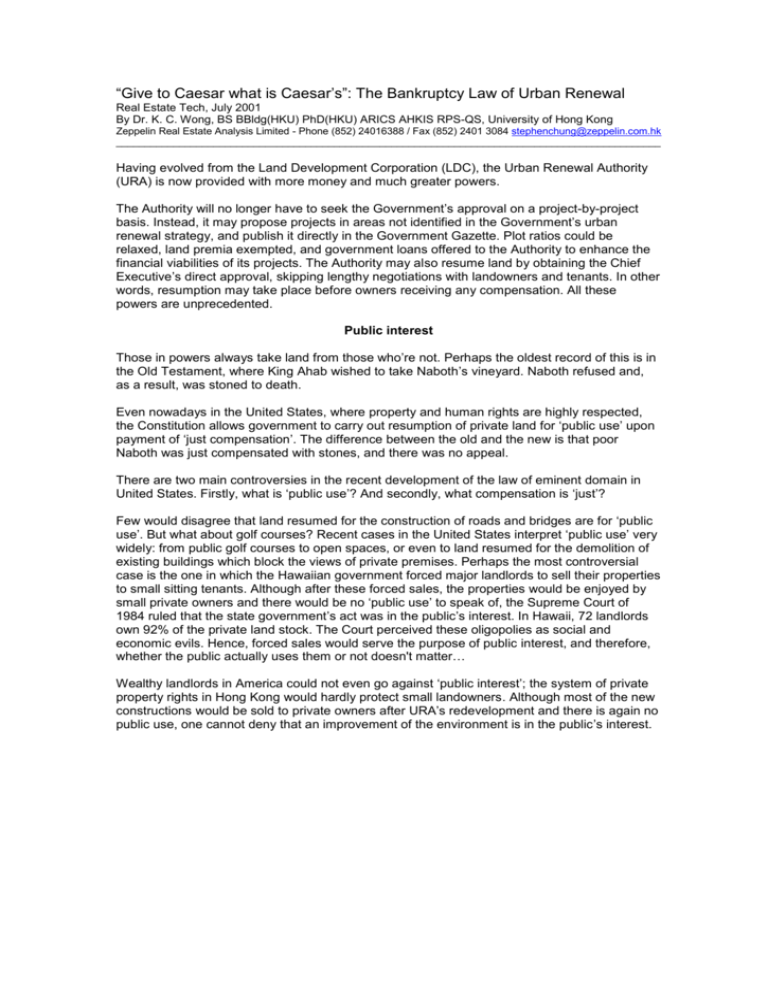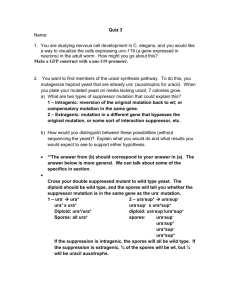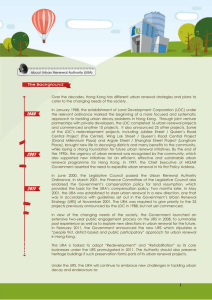Real Estate Tech, July 2001 - Zeppelin Property Consultants Limited
advertisement

“Give to Caesar what is Caesar’s”: The Bankruptcy Law of Urban Renewal Real Estate Tech, July 2001 By Dr. K. C. Wong, BS BBldg(HKU) PhD(HKU) ARICS AHKIS RPS-QS, University of Hong Kong Zeppelin Real Estate Analysis Limited - Phone (852) 24016388 / Fax (852) 2401 3084 stephenchung@zeppelin.com.hk _______________________________________________________________________________________________ Having evolved from the Land Development Corporation (LDC), the Urban Renewal Authority (URA) is now provided with more money and much greater powers. The Authority will no longer have to seek the Government’s approval on a project-by-project basis. Instead, it may propose projects in areas not identified in the Government’s urban renewal strategy, and publish it directly in the Government Gazette. Plot ratios could be relaxed, land premia exempted, and government loans offered to the Authority to enhance the financial viabilities of its projects. The Authority may also resume land by obtaining the Chief Executive’s direct approval, skipping lengthy negotiations with landowners and tenants. In other words, resumption may take place before owners receiving any compensation. All these powers are unprecedented. Public interest Those in powers always take land from those who’re not. Perhaps the oldest record of this is in the Old Testament, where King Ahab wished to take Naboth’s vineyard. Naboth refused and, as a result, was stoned to death. Even nowadays in the United States, where property and human rights are highly respected, the Constitution allows government to carry out resumption of private land for ‘public use’ upon payment of ‘just compensation’. The difference between the old and the new is that poor Naboth was just compensated with stones, and there was no appeal. There are two main controversies in the recent development of the law of eminent domain in United States. Firstly, what is ‘public use’? And secondly, what compensation is ‘just’? Few would disagree that land resumed for the construction of roads and bridges are for ‘public use’. But what about golf courses? Recent cases in the United States interpret ‘public use’ very widely: from public golf courses to open spaces, or even to land resumed for the demolition of existing buildings which block the views of private premises. Perhaps the most controversial case is the one in which the Hawaiian government forced major landlords to sell their properties to small sitting tenants. Although after these forced sales, the properties would be enjoyed by small private owners and there would be no ‘public use’ to speak of, the Supreme Court of 1984 ruled that the state government’s act was in the public’s interest. In Hawaii, 72 landlords own 92% of the private land stock. The Court perceived these oligopolies as social and economic evils. Hence, forced sales would serve the purpose of public interest, and therefore, whether the public actually uses them or not doesn't matter… Wealthy landlords in America could not even go against ‘public interest’; the system of private property rights in Hong Kong would hardly protect small landowners. Although most of the new constructions would be sold to private owners after URA’s redevelopment and there is again no public use, one cannot deny that an improvement of the environment is in the public’s interest. There is a price for the soul, and of course there is also one for land. In the final analysis, the question is whether the price is reasonable. Fragmented Ownership LDC used to compensate owners on values of similar age properties in the same district. Yet compared to the redevelopment potential, these prices are often very low. Old buildings could be reconstructed many times higher and sold at much more attractive prices. Owners would therefore find it difficult to accept compensation at a small fraction of the full development potential. Of course, it is possible under the law of eminent domain to assess compensation on the basis of the ‘value after development’. But in doing so the law courts would have to consider the 'possibility of assemblage'. In Hong Kong, aggressive developers had assembled most of the land that could be assembled. The vast majority of those awaiting the URA are lots owned by too many small owners, where effective negotiations are nearly impossible. Contrast to the west, the main problem of urban renewal in Hong Kong is fragmented ownership. This problem is particularly serious in high-density buildings. In Hong Kong, tens and hundreds of strata-titled owners might together share a tiny plot of land. The refusal of one single owner would prevent any redevelopment proposal. Population explosion in Hong Kong after the war had increased urban densities dramatically. Developers introduced strata titles, and marketed them to small buyers to increase the overall profits. Unfortunately, Deeds of Mutual Covenant were not introduced until much later. To make matters worst, the Hong Kong government introduced rent control in 1947. With such tiny rental revenues, owners hadn’t much incentive to maintain their buildings. All these contributed to the nightmare of urban decay. Therefore, the crux of the urban renewal problem is land resumption and compensation, not real estate development. A poorly maintained building is like a firm so badly managed that bankruptcy is desirable. It is only fair to declare bankruptcy then auction the firm's assets and compensate the creditors. But if the liquidator starts claiming the title of the firm and running the business himself, then not only this is a serious infringement of private property, but also going against the natural laws of the market. Private developers in Hong Kong are well known for their efficiencies that URA could hardly match against. Now the URA is expanding according to the Parkinson’s Law, compulsorily purchasing land and arming a big visible hand to the real estate market that they do not have a comparative advantage in. This is clearly not the solution to the problem of urban decay. Small owners could not enjoy the full redevelopment potential. Their properties condemned before any compensation is received. This may force them to go to the streets altogether, refusing land resumption. Without individual negotiations like those of the LDC, individual owners would easily form a united-front against the URA. Judging from the SAR’s repeated surrenders to protests after 1997, the URA may well become another “85,000 housing units policy”, hanging around for the time being, yet waiting to beat another hasty retreat. Give to the landlord what is the landlord's Whose portrait was on the Roman denarius? And now whose names are on the title deeds for land? If the government were to resume and auction the land, on which obsolete buildings are standing on, then part owners, as well as tenants, could be compensated according to some proportions and priorities of liquidation set out in advance. Considering the substantial auction prices representing the full market potentials of their land, these landlords will be more than happy to surrender their titles. As a result, urban renewal could be taken over by the free market and carried out at full speed, and everybody would be happy (except perhaps the URA). Like the LDC, the URA has these to offer: improving the environment, provision of public facilities, and protection of antiquities. The Planning Department's usual practice is to impose these requirements onto developers at the time of premium negotiations, or to state these requirements by way of zoning the sites into 'comprehensive development areas'. It is basically not necessary that the URA must have a part in order to achieve these. Nevertheless, private developers in the past often fulfilled all these requirements at much lower costs than the LDC. Regarding the financial viability of projects, there are two possibilities. Firstly, buildings may not be old or worn enough to be torn down. In this case, reconstruction is premature and the URA should not intervene. Secondly, reconstruction may not always imply a higher use and intensity than existing buildings and hence may not be viable. In this latter case, the government may lift the restrictions on the plot ratio of these sites a bit to suit. This is exactly what is proposed for the URA’s selected projects. The only difference is, the treasury would receive substantial land premiums from developers for building higher, while the URA has to borrow from the treasury instead. In a nutshell, the 'problem' of urban renewal in Hong Kong is fragmented ownership. Buildings not properly managed should go bankrupt. What Hong Kong needs is a Bankruptcy Law of Urban Renewal, not the URA. The last thing the government should do is to run a business of real estate. Now that the URA looks as if it is a 'strong leadership' policy, yet from the viewpoint of small landlords, it is clearly a tyranny. Landlords haven't gone to the streets yet because the URA hasn't launched it's first project with its full power. Should the government underestimate the owners and subsequently give up the policies of the URA, this 'strong leadership' policy might unfortunately become another laughing stock of the SAR. Give to Caesar what is Caesar’s and to the landlord what is the landlord's. Now that the Housing Authority is already the biggest landlord of the world, why should the government condemn small landlords to become an even bigger Caesar? _____________________________________________________________________ References: 1. Eaton, J.D., Real Estate Valuation in Litigation, second edition 1995, Appraisal Institute. 2. The Urban Renewal Authority Bill, Consultation paper, http://www.pelb.gov.hk/ura/consult.htm Click here to return: Real Estate Tech









